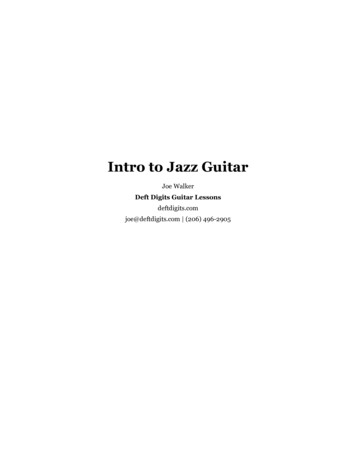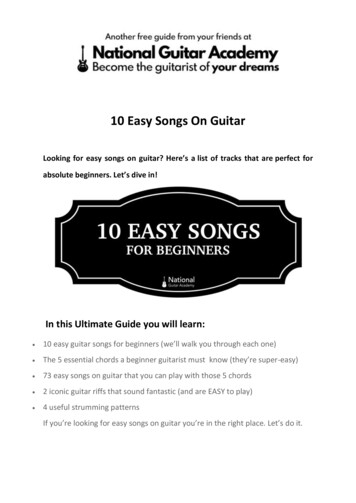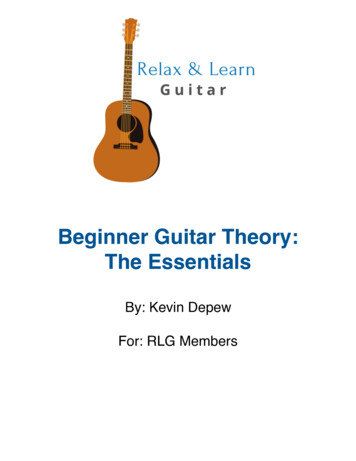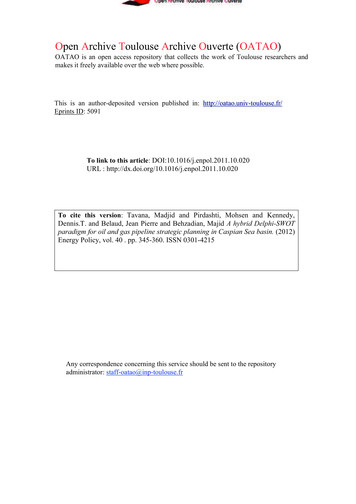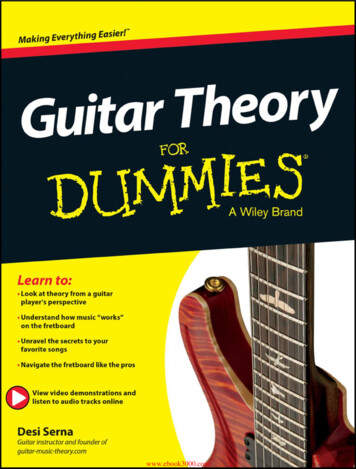
Transcription
www.ebook3000.com
Guitar Theoryby Desi Sernawww.ebook3000.com
Guitar Theory For Dummies Published by: John Wiley & Sons, Inc., 111 River Street, Hoboken, NJ 07030-5774, www.wiley.comCopyright 2014 by John Wiley & Sons, Inc., Hoboken, New JerseyMedia and software compilation copyright 2014 by John Wiley & Sons, Inc. All rights reserved.Published simultaneously in CanadaNo part of this publication may be reproduced, stored in a retrieval system or transmitted in any form or by any means,electronic, mechanical, photocopying, recording, scanning or otherwise, except as permitted under Sections 107 or 108 ofthe 1976 United States Copyright Act, without the prior written permission of the Publisher. Requests to the Publisher forpermission should be addressed to the Permissions Department, John Wiley & Sons, Inc., 111 River Street, Hoboken, NJ07030, (201) 748-6011, fax (201) 748-6008, or online at http://www.wiley.com/go/permissions.Trademarks: Wiley, For Dummies, the Dummies Man logo, Dummies.com, Making Everything Easier, and related tradedress are trademarks or registered trademarks of John Wiley & Sons, Inc., and may not be used without written permission.All other trademarks are the property of their respective owners. John Wiley & Sons, Inc., is not associated with anyproduct or vendor mentioned in this book.Limit of Liability/Disclaimer of Warranty: while the publisher and author have used their bestefforts in preparing this book, they make no representations or warranties with respect to theaccuracy or completeness of the contents of this book and specifically disclaim any implied warranties of merchantability or fitness for a particular purpose. no warranty may be created orextended by sales representatives or written sales materials. The advice and strategies containedherein may not be suitable for your situation. you should consult with a professional whereappropriate. neither the publisher nor the author shall be liable for damages arising herefrom.For general information on our other products and services, please contact our Customer Care Department within the U.S.at 877-762-2974, outside the U.S. at 317-572-3993, or fax 317-572-4002. For technical support, please visit www.wiley.com/techsupport.Wiley publishes in a variety of print and electronic formats and by print-on-demand. Some material included with standardprint versions of this book may not be included in e-books or in print-on-demand. If this book refers to media such as aCD or DVD that is not included in the version you purchased, you may download this material at http://booksupport.wiley.com. For more information about Wiley products, visit www.wiley.com.Library of Congress Control Number: 2013944338ISBN 978-1-118-64677-9 (pbk); ISBN 978-1-118-64687-8 (ebk); ISBN 978-1-118-64693-9 (ebk); ISBN 978-1-118-64703-5 (ebk)Manufactured in the United States of America10 9 8 7 6 5 4 3
Contents at a GlanceIntroduction. 1Part I: Getting Started with Guitar Theory. 5Chapter 1: Guitar Theory in a Nutshell.7Chapter 2: Navigating the Fretboard Like a Pro.15Part II: Working with Chords from the Ground Up. 33Chapter 3: Harmonizing the Major Scale to Form Triads and Chords.35Chapter 4: Forming Chord Shapes with the CAGED System.41Chapter 5: Adding Chord Tones and Extensions to Chords.71Part III: Getting to Know Keys, Modes, and Chord Progressions. 91Chapter 6: Playing Chord Progressions by Numbers.93Chapter 7: Knowing Music Inside Out: Identifying Tonics, Keys, and Modes.103Chapter 8: Following Key Changes.129Chapter 9: Dominant Function and Voice Leading.143Chapter 10: Filling the Gaps with Passing Chords.153Part IV: Playing Guitar Scales. 165Chapter 11: Preparing for Riffs and Solos with the Pentatonic Scale.167Chapter 12: Playing Music’s Primary Melody Maker: The Major Scale.187Chapter 13: Playing in Modes and Using Modal Scale Patterns.205Chapter 14: Exploring New Patterns with the Harmonic Minor Scale.225Chapter 15: Playing the Blues.239Part V: Part of Tens. 251Chapter 16: Ten Guitar Songs Worth Learning.253Chapter 17: Ten Sample Scale Applications.265Chapter 18: Tens Ways to Put Theory into Practice.269Appendix: Audio Tracks and Video Clips. 273Index. 277www.ebook3000.com
Table of ContentsIntroduction. 1About This Book.1Foolish Assumptions.2Icons Used in This Book.3Beyond the Book.3Where to Go from Here.3Part I: Getting Started with Guitar Theory. 5Chapter 1: Guitar Theory in a Nutshell.7Why Learn Guitar Theory?.7Navigating the Fretboard.8Seeing the fretboard as a grid.8Viewing neck diagrams.8Reading guitar tablature.10Playing Scales.11Pentatonic scale.11Major scale.12Modes.12Harmonic minor scale.12Working with Chords.12CAGED chord system.12Adding chord tones and extensions.13Passing chords.13Charting chord progressions.13Testing Your Guitar Theory Knowledge.13Chapter 2: Navigating the Fretboard Like a Pro.15Tracing Everything Back to Strings 6 and 5.16Moving between pitches with whole steps and half steps.18Naming the pitches between natural notes: Sharps and flats.18Grouping notes.20Tracking Notes and Playing Songs with Octaves.22Shaping octaves with your 1st finger on strings 6 and 5.23Shaping octaves with your 1st finger on strings 4 and 3.24Shaping octaves that are three strings apart.24Repeating octaves beyond the 12th fret.24Measuring the Space between Pitches with Intervals.26Playing intervals 1 through 7.27Filling in the gaps with flats and sharps.30www.ebook3000.com
viGuitar Theory For DummiesPart II: Working with Chords from the Ground Up. 33Chapter 3: Harmonizing the Major Scale to Form Triads and Chords.35Building Triads and Chords.35Major triad: Building from the 1st scale degree of the major scale.36Minor triad: Building from the 2nd scale degree of the major scale.37Playing through the Seven Triads of the Major Scale.38Playing the Chord Sequence of the Major Scale.39Chapter 4: Forming Chord Shapes with the CAGED System.41Making Chord Inversions and Chord Voicings.41Using the C Form.42Using the C form as a moveable barre chord.43Playing a C form arpeggio pattern.45Playing C form chord voicings.46Using the A Form.49Using the G Form.51Using the E Form.53Using the D Form.55Connecting the Five CAGED Forms.57Starting on C.57Starting on A.59Starting on G.60Starting on E.61Starting on D.62Sample CAGED Chord Changes.63Playing Minor CAGED Forms.65Playing the C minor form.65Playing the A minor form.65Playing the G minor form.66Playing the E minor form.66Playing the D minor form.67Connecting the Five Minor CAGED Forms.
viii Guitar Theory For Dummies Secondary Dominants . 146 Drawing attention to some common secondary dominants . 146


